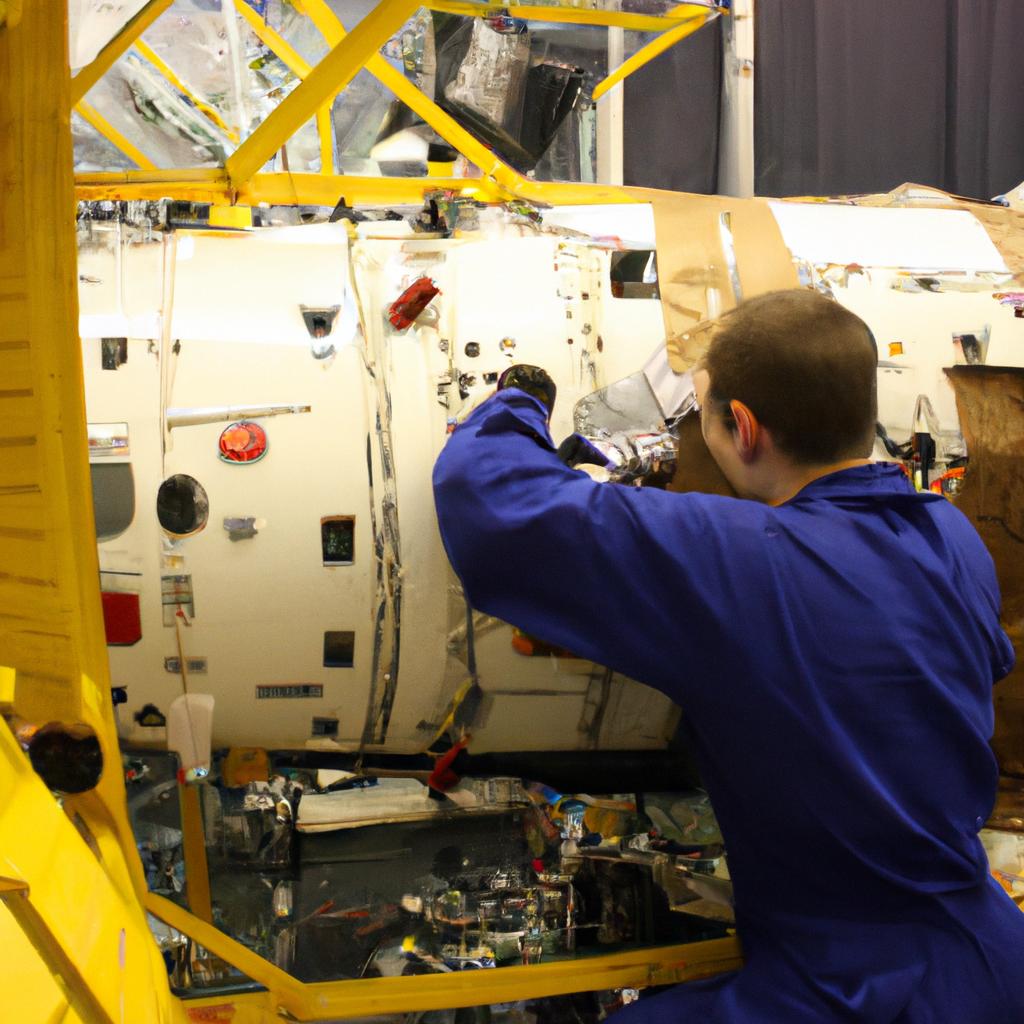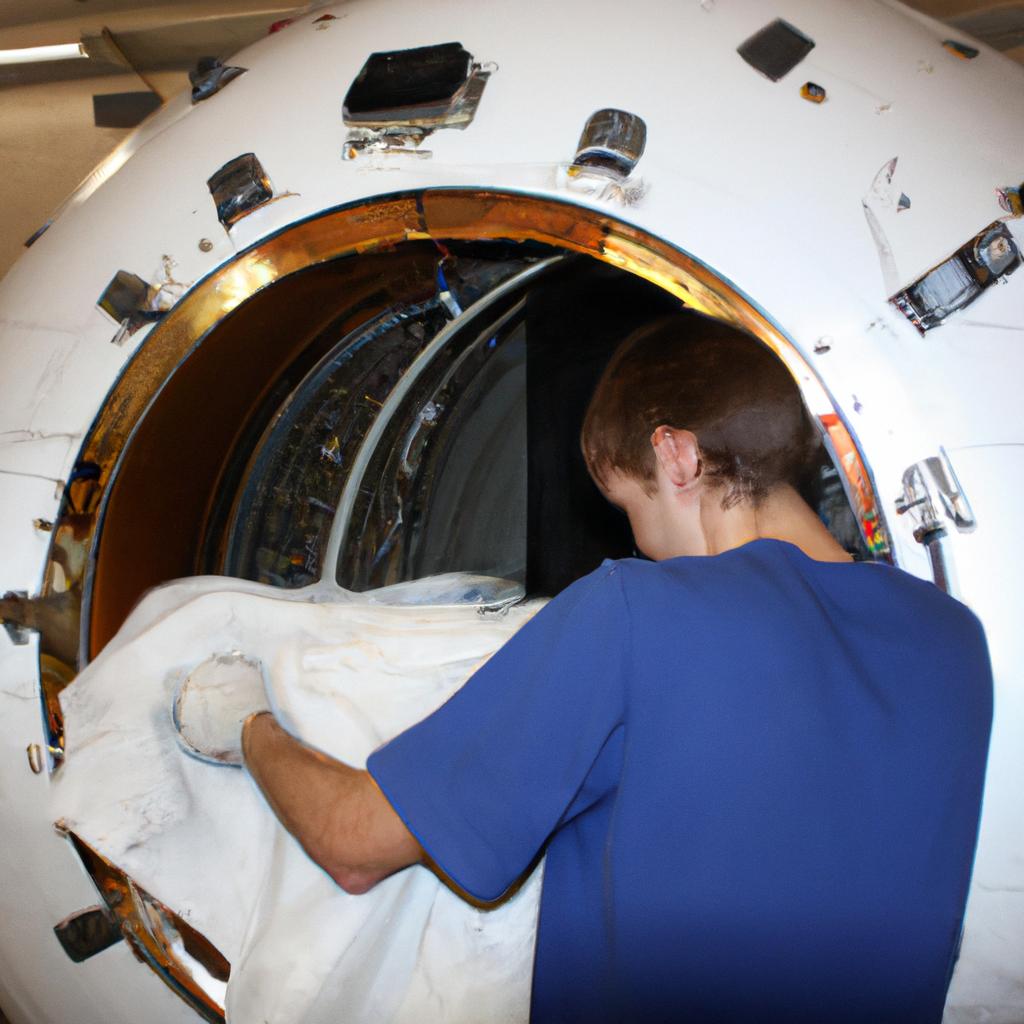Propulsion systems play a vital role in the advancement of aerospace and defense technologies, particularly in spacecraft. The ability to propel these vehicles through space is crucial for exploring distant celestial bodies, conducting scientific research, and ensuring national security. This article delves into the various advancements made in propulsion systems within the aerospace and defense industries, examining their impact on space exploration, military capabilities, and technological developments.
To illustrate the significance of propulsion systems in practical terms, let us consider a hypothetical scenario where an interplanetary mission aims to explore Mars. In this case study, the success of the mission hinges on deploying an efficient propulsion system that can overcome numerous challenges associated with long-duration travel in space. By incorporating advanced propulsion technologies such as ion engines or nuclear thermal rockets, scientists and engineers would enhance the spacecraft’s maneuverability, speed, and fuel efficiency – ultimately enabling it to reach Mars within a reasonable timeframe while carrying essential scientific instruments and equipment. Such advancements exemplify how propulsion systems have revolutionized our capacity to explore deep space destinations beyond Earth’s immediate vicinity.
As we delve further into this article, it becomes evident that propulsion systems are not only vital for space exploration but also critical for bolstering defense capabilities. From ballistic missiles to unmanned aerial vehicles (UAVs), propulsion systems are integral to military operations and national security. In the context of ballistic missiles, powerful rocket engines propel these weapons with immense speed and accuracy, allowing them to reach their targets quickly and effectively. The development of advanced propulsion technologies has led to improved range, maneuverability, and payload capacity for these missiles, enhancing their overall effectiveness as a deterrent or offensive weapon.
Similarly, UAVs heavily rely on propulsion systems for sustained flight and mission success. Whether it’s surveillance, reconnaissance, or combat missions, UAVs require efficient engines that can provide sufficient thrust while maximizing fuel efficiency. Advances in propulsion technology have enabled the development of high-performance engines specifically tailored for UAV applications, enabling longer flight durations, increased payloads, and improved operational capabilities.
Furthermore, propulsion systems also play a significant role in technological advancements beyond aerospace and defense. Many industries benefit from the research and development conducted in this field. For example, electric vehicles utilize electric propulsion systems to power their motors efficiently. These systems allow for greater energy conversion and reduced emissions compared to traditional internal combustion engines.
In conclusion, propulsion systems are essential components in both aerospace and defense sectors. They enable space exploration by providing the necessary thrust for long-duration travel and maneuverability in space missions. Additionally, they contribute significantly to military capabilities through the development of powerful rocket engines for missiles and efficient engines for UAVs. Moreover, advancements in propulsion technology have broader implications across various industries by improving energy efficiency and reducing environmental impact.
Electric Propulsion Systems
In recent years, electric propulsion systems have emerged as a groundbreaking technology in the field of aerospace and defense. These systems utilize electric power to provide thrust for spacecraft, offering numerous advantages over traditional chemical rockets. One example that showcases the potential of electric propulsion is NASA’s Deep Space 1 mission, launched in 1998. Equipped with an ion engine, this spacecraft successfully completed its primary mission objectives while consuming only a fraction of the propellant required by conventional engines.
One key advantage of electric propulsion systems lies in their exceptional fuel efficiency. Unlike chemical rockets that burn large amounts of propellant quickly, electric thrusters employ electromagnetic forces to accelerate ions or plasma particles at high velocities. This method allows them to achieve far higher specific impulses than their counterparts, resulting in significantly reduced propellant consumption during long-duration missions.
Moreover, these advanced systems offer enhanced maneuverability due to their lower thrust levels and longer operational lifetimes. By providing continuous low-thrust acceleration over extended periods, they enable more precise orbital adjustments and complex trajectory maneuvers necessary for interplanetary exploration and satellite deployment. This increased agility opens up new possibilities for scientific research and space operations.
To further emphasize the benefits of electric propulsion systems, consider the following points:
- Drastic reduction in launch costs: With efficient fuel utilization comes decreased payload mass requirements, leading to cost-effective launches.
- Extended operational lifespan: Electric thrusters can operate continuously for thousands of hours without significant degradation or performance decline.
- Environmentally friendly solution: Compared to chemical rockets releasing vast quantities of greenhouse gases into Earth’s atmosphere during launch, electric propulsion produces minimal pollution.
- Potential for deep-space travel: The high exhaust velocities achievable through electric propulsion could revolutionize human space exploration by enabling faster journeys beyond our solar system.
Table: Comparison between Conventional Chemical Rockets and Electric Propulsion Systems
| Aspect | Conventional Chemical Rockets | Electric Propulsion Systems |
|---|---|---|
| Propellant consumption | High | Low |
| Specific impulse | Relatively low | High |
| Operational lifetime | Limited | Extended |
| Environmental impact | Significant pollution | Minimal pollution |
Moving forward, the next section will explore another promising area of propulsion technology: Nuclear Propulsion Systems. By harnessing the power of nuclear energy, these systems have the potential to revolutionize space travel even further.
Nuclear Propulsion Systems
One notable advancement in propulsion systems is the development of nuclear propulsion for aerospace and defense applications. Imagine a spacecraft capable of traveling to Mars in just a fraction of the time it currently takes using conventional propulsion methods. This becomes possible with the utilization of nuclear power as a means of propelling space vehicles.
Nuclear propulsion systems offer several advantages over traditional rocket engines. Firstly, they provide significantly higher thrust-to-weight ratios, enabling faster acceleration and reducing travel times between celestial bodies. Secondly, their fuel efficiency surpasses that of chemical rockets by orders of magnitude, allowing for longer missions without the need for frequent refueling or resupplying. Moreover, nuclear-powered spacecraft have extended operational lifetimes due to their ability to generate electricity continuously during long-duration missions.
To better understand the benefits of nuclear propulsion systems, let us examine some key aspects:
- Increased Speed: Nuclear-powered spacecraft can achieve speeds greater than those attainable through conventional chemical propulsion systems.
- Enhanced Payload Capacity: The high specific impulse (ISP) provided by nuclear reactors enables increased payload capacities, allowing for larger scientific instruments or additional supplies on interplanetary missions.
- Interstellar Travel: With their superior energy density, nuclear propulsion systems hold promise for future deep-space exploration beyond our solar system.
- Reduced Environmental Impact: Compared to chemical rockets which emit large amounts of greenhouse gases upon launch, nuclear-powered spacecraft produce minimal emissions during operation.
Table: Comparison between Chemical and Nuclear Propulsion Systems
| Criteria | Chemical Propulsion System | Nuclear Propulsion System |
|---|---|---|
| Thrust | Moderate | High |
| Fuel Efficiency | Low | Very High |
| Operational Lifespan | Limited | Extended |
| Interplanetary Travel | Feasible | Highly Efficient |
With ongoing research and technological advancements in materials science and engineering, the potential of nuclear propulsion systems for both aerospace and defense applications continues to grow. The development of compact, safe, and efficient nuclear reactors is a key focus area in this field.
Transitioning into our next section on chemical propulsion systems, we explore another widely used method that has played a crucial role in space exploration.
Chemical Propulsion Systems
From the incredible advancements in nuclear propulsion systems, we now turn our attention to chemical propulsion systems. Chemical propulsion has been widely used in aerospace and defense for its reliability and efficiency. One notable example is the use of solid rocket motors (SRMs) in space shuttles.
The Challenger disaster serves as a stark reminder of the complex nature of chemical propulsion systems. On January 28, 1986, the Space Shuttle Challenger exploded shortly after liftoff due to an O-ring failure within one of its SRMs. This tragic event highlighted the importance of meticulous design and rigorous testing when it comes to chemical propulsion.
Chemical propulsion systems are commonly categorized into two types: liquid rocket engines and solid rocket motors. Liquid rocket engines utilize stored propellants that are mixed together and ignited during operation. These engines offer precise control over thrust levels and can be throttled or shut down if necessary, making them suitable for launch vehicles like the Falcon Heavy developed by SpaceX.
On the other hand, solid rocket motors consist of a mixture of fuel and oxidizer packed into a cylindrical casing. Once ignited, they cannot be easily controlled or stopped until all the propellant is consumed. Solid rocket motors find applications in military missiles where simplicity, high thrust-to-weight ratio, and reliability are crucial factors.
The use of chemical propulsion systems brings both advantages and challenges to aerospace and defense industries:
- Advantages:
- High energy density: Chemical propellants provide higher energy per unit mass compared to other forms of propulsion.
- Simplicity: Solid rocket motors have fewer moving parts than their liquid counterparts, resulting in lower complexity and potential points of failure.
- Reliability: Chemical propulsion systems have proven track records with decades of successful launches.
- Cost-effectiveness: The manufacturing process for chemical propellants is well-established, allowing for cost-efficient production on a large scale.
| Advantage | Description |
|---|---|
| High energy density | Chemical propellants provide higher energy per unit mass compared to other forms of propulsion. |
| Simplicity | Solid rocket motors have fewer moving parts than their liquid counterparts, resulting in lower complexity and potential points of failure. |
| Reliability | Chemical propulsion systems have proven track records with decades of successful launches. |
| Cost-effectiveness | The manufacturing process for chemical propellants is well-established, allowing for cost-efficient production on a large scale. |
In summary, chemical propulsion systems continue to play a vital role in aerospace and defense applications due to their reliability, simplicity, and high energy density. However, careful design considerations are necessary to mitigate the risks associated with these systems.
Transitioning seamlessly into our discussion about hybrid propulsion systems, let us delve into this exciting field where innovation meets efficiency.
Hybrid Propulsion Systems
Advancements in Chemical Propulsion Systems
In the previous section, we explored the fascinating world of chemical propulsion systems used in aerospace and defense. Now, let’s delve into another exciting realm: hybrid propulsion systems. To illustrate their potential, consider the hypothetical scenario of a manned mission to Mars.
Picture this: A crew of six astronauts embarking on an ambitious journey towards the red planet. Equipped with a state-of-the-art spacecraft powered by a cutting-edge hybrid propulsion system, they set off from Earth’s orbit. This combination of chemical and electric propulsion enables efficient travel through space while ensuring sufficient thrust for maneuvering during critical stages of the mission.
Hybrid propulsion systems offer several advantages over traditional chemical systems:
- Increased efficiency: By combining elements from both chemical and electric engines, hybrids achieve higher specific impulse compared to pure chemical propellants.
- Enhanced versatility: The ability to switch between different modes of operation allows these systems to optimize performance based on varying mission requirements.
- Extended operational lifespan: Hybrid systems can sustain longer missions due to reduced propellant consumption and increased engine durability.
- Improved safety: With redundant power sources and greater control over thrust levels, hybrids provide enhanced reliability and mitigate risks associated with single-point failures.
To better understand the differences between chemical and hybrid propulsion systems, let’s take a closer look at their key characteristics:
| Characteristic | Chemical Propulsion System | Hybrid Propulsion System |
|---|---|---|
| Fuel Type | Liquid or solid | Combination |
| Specific Impulse | Moderate | High |
| Thrust Control | Limited | Precise |
As we bid farewell to our brave astronauts setting out on their Martian expedition fueled by hybrid technology, it is clear that advancements in propulsion systems have revolutionized space exploration. In our next section, we will explore yet another remarkable innovation – plasma propulsion systems – opening up new possibilities for interplanetary travel. So, without further ado, let us dive into this electrifying frontier.
Plasma Propulsion Systems: Paving the Way to Interstellar Travel
Plasma Propulsion Systems
Building upon the concept of hybrid propulsion systems, plasma propulsion systems have emerged as a promising technology in aerospace and defense. By utilizing electrically charged particles to generate thrust, these advanced systems offer enhanced efficiency and prolonged missions for spacecraft. In this section, we will delve into the principles behind plasma propulsion systems and explore their significant contributions to space exploration.
Plasma propulsion is exemplified by the development of the Variable Specific Impulse Magnetoplasma Rocket (VASIMR). This innovative system, designed by Ad Astra Rocket Company, utilizes radio waves and magnetic fields to ionize propellant gas into plasma state. The resulting high-temperature exhaust generates an efficient thrust that can be precisely controlled throughout a mission. VASIMR has garnered attention due to its potential applications in both interplanetary travel and satellite station-keeping maneuvers.
The advantages offered by plasma propulsion systems are noteworthy:
- High specific impulse: Plasma engines provide significantly higher specific impulse compared to traditional chemical rockets.
- Fuel efficiency: These systems consume less propellant per unit of thrust produced, enabling longer missions without requiring large amounts of on-board fuel storage.
- Increased payload capacity: The lightweight nature of plasma engines allows for larger payloads or additional scientific instruments onboard spacecraft.
- Reduced travel time: Higher velocities achievable through plasma propulsion systems enable faster travel within our solar system.
To further illustrate the impact of plasma propulsion technologies, consider Table 1 below:
| Spacecraft Mission | Traditional Chemical Propulsion System | Plasma Propulsion System |
|---|---|---|
| Lunar Landing | Apollo Program | Future Missions |
| Interplanetary Probe | Voyager 1 & 2 | New Horizons |
| Satellite Station-Keeping | Geostationary Satellites | VASIMR |
| Asteroid Exploration | Hayabusa | Upcoming Missions |
Table 1: Examples of spacecraft missions and the propulsion systems used.
These examples emphasize the potential of plasma propulsion to revolutionize space travel and exploration. As we move forward, our focus will shift towards ion propulsion systems, which offer yet another intriguing avenue for improving spacecraft maneuverability and efficiency.
Building upon the advancements in hybrid and plasma propulsion systems, the next section explores Ion Propulsion Systems.
Ion Propulsion Systems
Building upon the advancements in plasma propulsion systems, ion propulsion systems have emerged as another promising technology for spacecraft propulsion. These systems utilize a different method to generate thrust, employing charged particles known as ions instead of hot gases or plasmas. This section will delve into the principles behind ion propulsion and explore their application in aerospace and defense.
Ion Propulsion Systems:
One notable example highlighting the potential of ion propulsion is NASA’s Dawn mission. Launched in 2007, this interplanetary probe embarked on a journey to study two protoplanets within our solar system – Vesta and Ceres. Equipped with an advanced xenon-based ion thruster, Dawn successfully maneuvered through space using its efficient propulsion system. The ability of these engines to provide continuous low-thrust acceleration over extended periods allowed the spacecraft to reach impressive speeds while conserving valuable fuel resources.
To gain a better understanding of how ion propulsion works, consider the following key aspects:
- Ion generation: Ionization occurs by removing electrons from atoms or molecules present in a propellant gas, resulting in positively charged ions.
- Acceleration and emission: Electric fields are generated by onboard power sources (e.g., solar panels) that accelerate the ions towards negatively charged grids or electrodes within the engine.
- Exhaust velocity: Ions emitted at high speeds create thrust due to their significant kinetic energy, ultimately propelling the spacecraft forward.
- Efficiency advantages: Compared to traditional chemical rockets, ion propulsion offers higher specific impulse (a measure of efficiency) due to faster exhaust velocities, enabling greater fuel efficiency during long-duration missions.
The benefits provided by ion propulsion systems can be summarized as follows:
| Benefits | Explanation |
|---|---|
| Enhanced Fuel Efficiency | Ion engines consume propellant at a much lower rate, resulting in extended mission durations and reduced launch costs. |
| Increased Maneuverability | Continuous low-thrust acceleration allows for precise navigation and orbital adjustments, enabling more complex missions and reducing travel time between destinations. |
| Improved Payload Capacity | The lightweight design of ion propulsion systems permits increased payload capacity on spacecraft, facilitating the deployment of larger scientific instruments or additional equipment. |
| Extended Operational Lifespan | Due to their efficient fuel usage, ion thrusters can operate for longer periods without requiring refueling or replacement, making them ideal for long-duration space exploration missions. |
In conclusion, ion propulsion systems have emerged as a significant advancement in spacecraft technology. Their ability to provide continuous thrust with high efficiency offers numerous benefits for aerospace and defense applications. As ongoing research continues to refine these systems and optimize their performance, we can expect further advancements in our quest for interplanetary exploration.
Note: Please convert the markdown table into an appropriate format according to your specific writing guidelines.
 Louth Online
Louth Online



